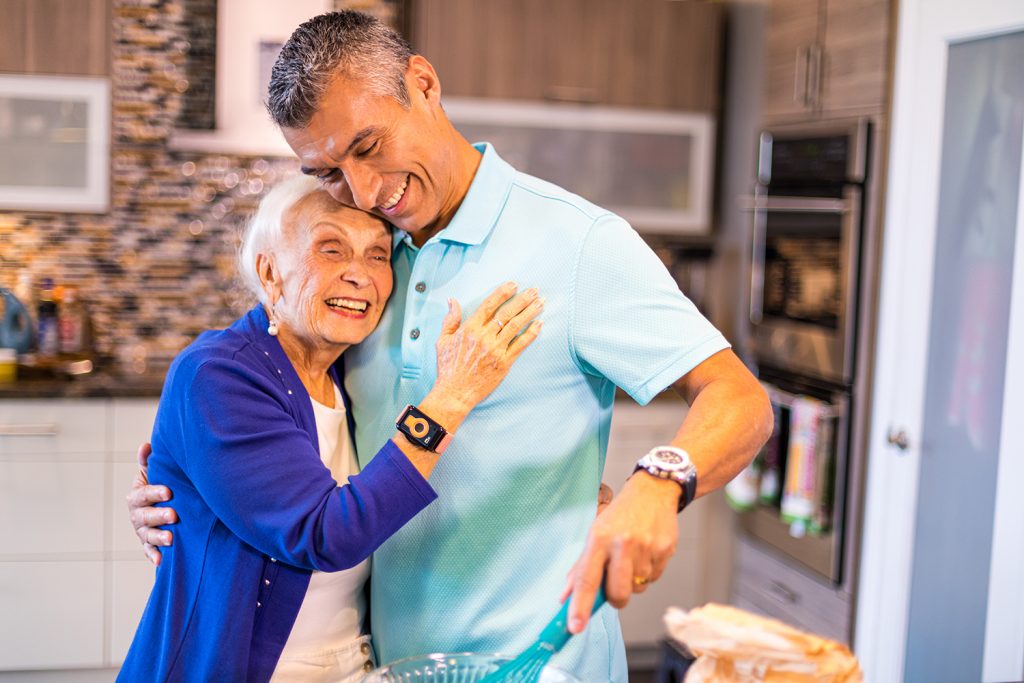
Protecting the elderly with technology
News Health & Fitness Devices Locks and Home Security Surveillance Cameras CarePredict CarePredict TouchPoint Marc Saltzman MPERS PERS
 PHOTO: CarePredict
PHOTO: CarePredict The need for communication, telehealth, and independent living solutions to assist seniors in living well and safely at home has never been greater.
With the current global COVID-19 pandemic exposing the vulnerability of the senior population, Parks Associates research shows that as of Nov. 2020, 80 per cent of Americans who have died of COVID-19 were age 65 or older.
As a result of this much higher level of risk, older consumers have taken stronger precautions to keep themselves safe. To give peace of mind to caregivers, smart tech has evolved to provide solutions so that more seniors can stay in their home for longer.
Technology expert Marc Saltzman believes that smart technology plays a vital role in helping to keep seniors at home for longer.
“If my mom or my grandfather, so to speak, could live at home without having to go into an assisted living environment, especially given how hard hit [seniors] were with COVID, technology can play a role,” Saltzman said in an interview with Smart Homes.
With consent, Saltzman is a firm believer in having cameras installed in the home, or having one camera for caregivers to check in on a regular basis over zoom or Skype. Smart technology can also play a role in prompting seniors to take their medication in lieu of a caretaker.
“There are some smart pill reminders and dispensers that can help those so people aren’t forgetting to take their medication or, heaven forbid, they forgot that they take their meds,” Saltzman relates. “Pill reminders and pill dispensers can help there since it’s all automated.”
An avenue that Saltzman has seen rise in popularity for aging-in-place technologies are fall detectors. Noting that the Apple Watch has fall detection capabilities, Saltzman explains that if the wearable technology detects a fall, it will ask the user if they are okay. If not “[the Apple Watch] can quote call through like your contacts and emergency services.”
“Those smartwatches are also becoming very important health tools right there’s built-in electrocardiogram (ECG) features with the latest Apple Watch Series six years of blood oxygen monitor so if it falls below. Say 90% it can notify you that there could be some respiratory or cardiac issues,” Saltzman explains.
Plantation, Fla.-based CarePredict offers users CarePredict’s Tempo, a smart wearable designed exclusively for seniors, that autonomously tracks subtle changes in a seniors’ daily activity and behavior patterns.
Recently, the company launched the CarePredict TouchPoint to accompany the Tempo. TouchPoint is an app that provides peace of mind to families and caregivers by providing continuous visibility into their loved one’s well-being.
TouchPoint was recently named a CES 2021 Innovation Awards Honoree in the “Health & Wellness” category.
“The idea [behind TouchPoint] was, ‘how can we assess the activity and behaviour patterns of a senior and use that information to predict when they’re at risk?’” explains Gerald “Jerry” Wilmink, chief business officer, CarePredict.
According to Wilmink, the TouchPoint detects subtle changes in everyday activities such as eating, walking, cooking, sleeping, and bathroom activities. Any deviations from changes are known to precede health conditions like UTI, malnutrition, depression, and an increased risk for falls.
“TouchPoint was designed to be more of a predictive platform,” Wilmink explains. “When an individual does fall, the wearable sensors can communicate right from the wearable device to other members of their care circle and it picks up the phone detects it, and transmits an open line of communication to a voice communication, like a walkie talkie.”
With a population that is getting older, Saltzman predicts that there will continue to be innovative smart technology solutions that will continue to develop and allow seniors to continue living at home.
“There is an increased focus to keep our loved ones longer at home independently,” Saltzman concludes. “With all of these new technologies on the market, I do see Aging in Place another trend that we’ll see in 2021.”